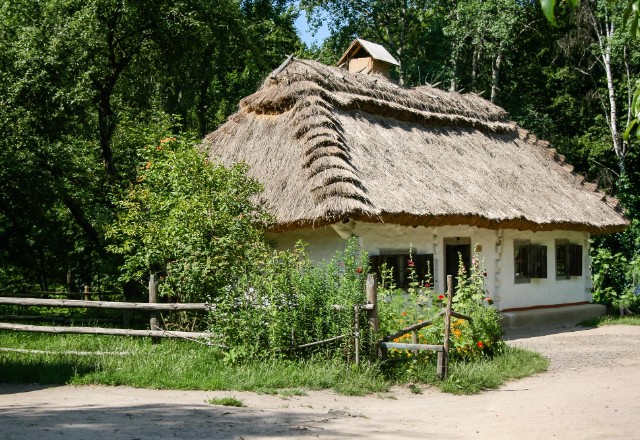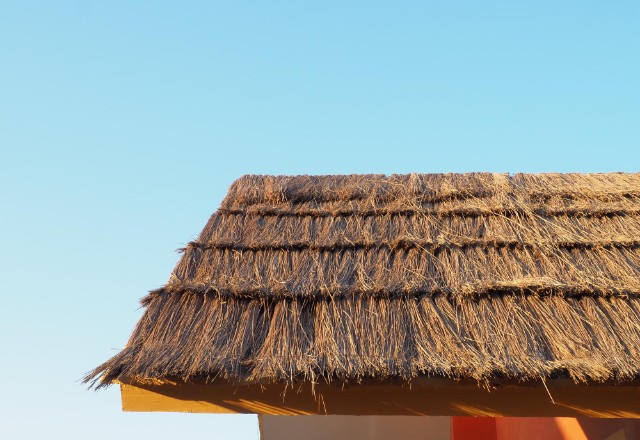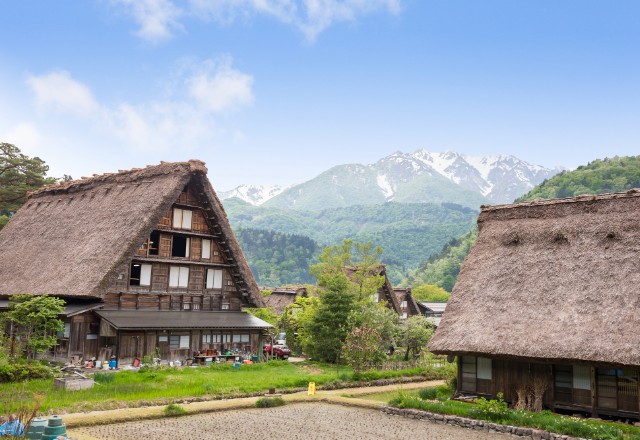A thatched roof is a traditional roofing system made of natural materials such as water reed or straw thatch. It is commonly used in older buildings and cottages, particularly in regions with a rich history of thatched dwellings. Thatched roofs have been part of architectural heritage for centuries due to their unique, rustic appearance and their ability to provide natural insulation. However, they require regular maintenance and proper craftsmanship to prolong their lifespan. Thatch roofs are known for their shorter lifespans compared to more modern roofing materials, largely due to their exposure to weather conditions and environmental factors. Nevertheless, when properly cared for and built with quality craftsmanship, a thatched roof can last for several decades.
Disclaimer: The information provided in this article is intended for informational purposes only. While we strive to offer accurate and current information, it should not be considered professional advice. Before taking any action, we recommend that you consult a qualified professional who can provide tailored advice specific to your situation. Advance Roofing LLC has been proudly providing the Spokane, WA area with superior roofing solutions for many years and we would be delighted to assist you with your own project.
Overview of the Lifespan of a Thatched Roof
Thatched roofs are known for their natural beauty and charm, but many property owners often wonder how long they can expect their thatched roof to last. The lifespan of a thatched roof can vary depending on several factors.
- The type and quality of materials used in the thatching process play a significant role in determining the roof’s longevity. Water reed is generally considered more durable and can last longer than straw thatch.
- The skill and experience of the thatcher also contribute to the lifespan of the roof. A well-trained and experienced thatcher will use proper building techniques and ensure thorough coverage and even layering of the thatch, which can enhance the roof’s durability.
- The roof pitch, or slope, is another crucial factor. Steeper roofs with a higher pitch tend to shed water more efficiently, reducing moisture retention and prolonging the roof’s life.
- The location of the property also affects a thatched roof’s lifespan. Weather conditions and climate factors, such as excessive rain or high humidity, can impact the roof’s condition. Thatched dwellings in temperate climates tend to have longer lifespans compared to those in areas with harsh weather conditions.
- Lastly, the level of maintenance plays a significant role in extending the lifespan of a thatched roof. Regular maintenance, such as brushing and re-ridging, can help prevent water retention and decay, ensuring the roof remains in good condition.
Types of Materials Used for Thatching

When it comes to thatching materials, there are several options available, with each offering its own unique benefits. Natural materials like water reed and straw thatch are commonly used for thatched roofs. The choice of material ultimately depends on factors such as the desired aesthetic, budget, and the specific requirements of the property.
Water Reed Thatch
Water reed thatch is a popular and durable material used for thatching roofs. It is known for its lifespan of 30 to 40 years, making it an excellent long-term investment for property owners.
- One of the key benefits of water reed thatch is its excellent insulation properties. It provides a natural insulator, helping to keep the property cool in the summer and warm in the winter. This can lead to energy savings and a more comfortable living environment.
- In addition, water reed thatch is highly resistant to fire and pests. The tightly woven reeds create a barrier that is difficult for flames to penetrate, reducing the risk of fire spreading. It also deters pests such as birds and insects, preventing damage to the roof structure.
- Water reed thatch can withstand various weather conditions, making it suitable for different climates. It can withstand heavy rain, strong winds, and even harsh winters. The natural materials used in water reed thatch allow for good air flow, preventing moisture buildup that can lead to mold or rot.
With proper maintenance and regular inspections, water reed thatch roofs can last for several decades.
Straw Thatch
Straw thatch has been used as a roofing material for centuries, dating back to ancient times. Historically, it was a common roofing choice in many regions due to its abundance and affordability. Today, straw thatch has evolved and is still used in various modern applications.
- One of the main benefits of using straw thatch for roofing is its natural insulating properties. It provides excellent heat insulation during the summer months and helps to retain warmth in colder climates.
- Additionally, straw thatch is often a more sustainable choice compared to other roofing materials, as it can be locally sourced and is biodegradable.
However, there are some limitations to consider when using straw thatch. It is vital to account for the regional climate and proper installation techniques to ensure durability. Straw thatch roofs require regular maintenance, including periodic rethatching and removal of debris to prevent moisture accumulation and pests.
Common types of straw thatch materials include wheat straw, rice straw, and rye straw. Each type has unique characteristics such as resilience and flexibility, depending on the climate and desired aesthetics.
Natural Materials for Thatching

Natural materials such as straw, water reed, sedge, rushes, heather, and palm branches are commonly used for thatching roofs. These materials provide a rustic and environmentally-friendly alternative to conventional roofing materials.
- Straw is one of the most widely used thatching materials. It is lightweight, readily available, and offers good insulation properties. Straw thatch is often made from wheat straw, rice straw, or rye straw, depending on the region’s availability and climate conditions.
- Water reed is another popular choice for thatched roofing. It is known for its durability and weather resistance. Water reed thatch is made from long, thick stems that are tightly bundled and secured to the roof structure. It can withstand strong winds and heavy rain, making it suitable for coastal or humid areas.
- Sedge is commonly used for thatched roofs in wetland regions. It has excellent water resistance and can endure damp conditions without rotting. Sedge thatching is typically thicker than other materials, providing extra insulation and protection against harsh weather conditions.
- Rushes and heather are often used for thatching in colder climates. Rushes are known for their dense and durable nature, while heather is valued for its natural beauty and ability to repel water.
- Palm branches are primarily used in tropical regions. They offer excellent resistance to wind and rain, making them ideal for areas prone to hurricanes or heavy storms.
Thatching techniques vary depending on the region’s building traditions, but generally involve layering the materials in an overlapping manner. This creates a tight and waterproof roof that allows for proper air flow and ventilation.
Building Techniques and Roof Pitch For Maximum Longevity
The longevity of a thatched roof greatly depends on the building techniques used and the pitch, or slope, of the roof. Proper construction and maintenance play crucial roles in ensuring the roof’s durability.
- Building techniques vary across regions, but generally involve layering the thatching materials in an overlapping manner. This creates a tight and waterproof roof that allows for proper air flow and ventilation, preventing moisture buildup and rot.
- Additionally, the pitch of the roof is carefully designed to shed water efficiently and reduce the risk of leaks. A steeper pitch is often recommended for maximum longevity, as it allows rainwater to quickly run off the roof, minimizing the chance of waterlogged thatch.
With the right construction techniques and roof pitch, a well-maintained thatched roof can last for decades, providing natural beauty and insulation to the property it covers.
Proper Maintenance to Extend the Life of a Thatched Roof
Proper maintenance is crucial to extend the lifespan of a thatched roof and ensure its durability. Regular inspections, cleaning, and repairs are key to preserving the roof’s integrity and maximizing its lifespan.
One important aspect of maintenance is promoting air circulation around the roof. This can be achieved by removing any nearby trees or plants that may obstruct the airflow. Adequate air circulation prevents the growth of moss and lichen, which can deteriorate the thatch over time.
Regular maintenance should include the removal of leaves, fir needles, moss, and algae that accumulate on the roof. These organic materials can trap moisture, leading to rot and fungal growth. It’s also essential to ensure that the roof dries out quickly after rain or snow, as prolonged dampness can accelerate thatch decay.
A professional thatcher should inspect the roof regularly to identify any signs of wear or damage. Small repairs should be addressed promptly to prevent further deterioration. It is recommended to hire an experienced thatcher who specializes in maintaining thatched roofs.
Factors Affecting the Lifespan of a Thatched Roof

The lifespan of a thatched roof can vary depending on several factors.
- One crucial factor is the type of material used in the thatching process. Different materials, such as water reed or straw thatch, have varying degrees of durability and resistance to decay. Water reed thatch, for example, is known for its longevity and can last for several decades with proper maintenance.
- The quality of craftsmanship is another factor that affects the lifespan of a thatched roof. A well-built thatched roof with skilled and experienced thatchers is more likely to withstand the test of time. Proper installation techniques, such as achieving the correct roof pitch, contribute to the longevity of the roof by ensuring proper water runoff and minimizing moisture retention.
- Normal weather conditions and environmental factors also play a significant role in the lifespan of a thatched roof. In areas with damp or wet climates, thatched roofs may have shorter lifespans due to increased moisture exposure. Harsh weather conditions, such as heavy rain or strong winds, can also impact the durability of a thatched roof.
- Regular maintenance and care are essential to prolonging the lifespan of a thatched roof. This includes removing organic debris like leaves and moss, ensuring adequate air circulation, and promptly addressing any signs of wear or damage. With proper maintenance and attention to these factors, a well-built and maintained thatched roof can provide a beautiful and functional roofing solution for many years.
Average Lifespans of Different Types of Thatched Properties
Thatched roofs have been used as a roofing material for centuries and are known for their natural beauty and insulative properties. However, the lifespan of a thatched roof can vary depending on various factors.
- For water reed thatch, which is considered one of the most durable materials, the average lifespan is around 50 to 70 years with proper maintenance.
- Straw thatch, on the other hand, may have a shorter lifespan of around 20 to 40 years.
The type of property also plays a role in determining the longevity of the thatched roof. Thatched cottages, which are typically smaller and have simpler roof structures, tend to have longer lifespans compared to larger or more complex buildings.
Additionally, the quality of craftsmanship, weather conditions, and regular maintenance are all crucial in ensuring the longevity of a thatched roof. By considering these factors and taking proper care of the roof, property owners can enjoy their thatched dwellings for many years to come.
Costs Involved in Replacing a Thatched Roof
Replacing a thatched roof can be a significant investment for property owners. The cost of replacement is influenced by several factors, including the size and complexity of the roof, the type of thatching material used, and any additional features or treatments desired.
- The size and complexity of the roof are key factors in determining the overall cost. A larger roof will require more materials and labor, increasing the overall expense.
- Additionally, roofs with irregular structures or multiple angles may require additional time and expertise during the replacement process, which can also contribute to higher costs.
- The type of thatching material used will also affect the cost. There are various types of thatching materials available, including water reed, straw thatch, and even palm fronds. Each material has its own unique qualities and price point, with water reed typically being the most expensive option.
- If additional features or treatments are desired, such as ridge replacement or fire retardant netting, these will add to the overall cost as well. These features may be necessary for safety or regulatory reasons, or simply for aesthetic purposes.
On average, the cost of replacing a thatched roof can range from $45 –90 K, depending on the factors mentioned above. It’s important to note that these figures are rough estimates and can vary depending on the specific circumstances of each project.
Benefits to Having a Long-Lasting Thatched Roof

Having a long-lasting thatched roof comes with a range of benefits that make it an appealing choice for homeowners.
- One key advantage is its breathability. Thatched roofs are made from natural materials such as water reed or straw thatch, allowing air to circulate and preventing the build-up of moisture. This helps maintain a comfortable living environment and reduces the risk of mold or dampness.
- Thatched roofs also have excellent insulation properties. The thickness and density of the thatch act as a natural insulator, keeping the interior of the property cool during hot summers and warm during cold winters. This can result in energy savings and reduced heating and cooling costs.
- In addition to being breathable and insulating, thatched roofs are also environmentally friendly. The use of natural materials means that the production and disposal processes have a lower carbon footprint compared to synthetic roofing materials. Thatched roofs can also be sourced locally, supporting local craftsmen and reducing transportation emissions.
- Aesthetically, thatched roofs have a timeless appeal that can enhance the overall look of a property. They add character and charm, particularly for traditional or period-style homes. Furthermore, having a well-maintained thatched roof can significantly increase the value of a property. Studies have shown that a house with a new roof sells for an average of $12,000 more than a house with an older roof.
Conclusion
Average lifespan of a thatched roof is anywhere between 25 to 50 years, although some can last much longer with proper care and maintenance. The cost of replacing a thatched roof depends on factors such as size, complexity, and the type of thatching material used. A well-maintained thatched roof offers numerous benefits, including breathability, insulation, energy savings, environmental friendliness, and increased property value. With proper care, craftsmanship, and maintenance, you can enjoy your thatched dwelling for many years to come. Although replacing a thatched roof can be expensive, the long-term benefits make it a worthwhile investment.



 509-201-4190
509-201-4190
